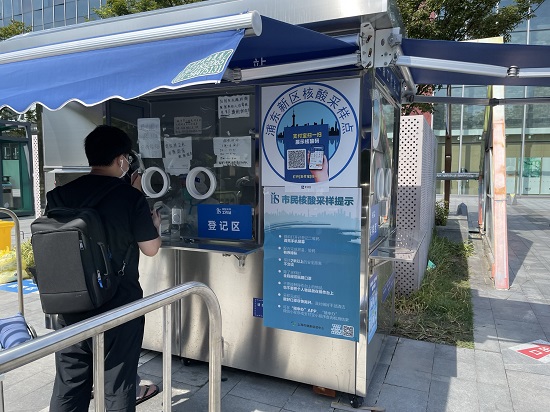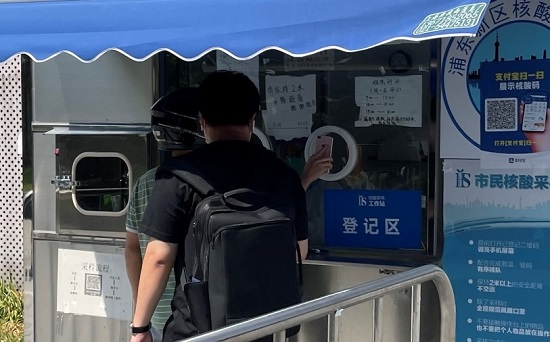Complete list is here: Index of Posts About the March 2022 Shanghai Covid Outbreak
---
Hi readers~ so here in Shanghai, basically we are all getting covid-tested every 2-3 days. (The reality is actually a little more complicated: To enter public places, you need to show you have a negative nucleic acid test from within the past 72 hours. But, a lot of times the security guards don't actually check- they just glance at your phone screen but not closely enough to see if it says "72" or "48" or whatever. But then there are some places that are more strict and require a 48-hour test, like if you go to a big crowded event where people won't be wearing masks, or if you take a flight/train/bus to a different city. And, if you don't go out to public places at all, then you can get away with not getting covid-tested, because nobody's going to track you down and check. But if you're not tested for 7 days, your health code will turn yellow. Which may or may not actually be a problem for you- it's quite possible that if you're not going anywhere anyway, you wouldn't really care if your health code turns yellow. Also, in the schools, they test all the students every single day. So, like I said it's complicated, but you can just think of it as "everyone gets tested every 2-3 days.")
My point is, I have some photos to share!
I want to show you how the nucleic acid testing process works, in practical terms, for people living here. (This is nucleic acid testing- also called PCR testing- 核酸 in Chinese. When I say they're requiring you to get covid-tested, it means a nucleic acid test. Rapid antigen tests [抗原 in Chinese] are sometimes used sort of as a backup, for example if you show up at your office building for work and you don't have the right nucleic acid test in the right timeframe, because you got nucleic-acid-tested but your result hasn't come back yet- they might make you take a rapid antigen test right there. But basically my point is, when I say "covid-tested" I am talking about nucleic acid testing.)
Anyway, photos!
So, first of all, the nucleic acid testing stations are these little booths that were constructed all over Shanghai near the end of the lockdown (mid/late May 2022). Wherever you are, there should be a test station within a few blocks. You can search for nearby test stations on the health code app. Most of them are only open certain hours (for example, the one in our apartment complex is open for 2 hours in the morning and 2 hours in the evening- so the idea is you can conveniently get tested before you go to work or after you come home from work). Some are open 24 hours.
Also, many test stations are inside apartment complexes and are only supposed to be used by the people who live there. This isn't a problem- there are tons of test stations in public areas, where anyone can get tested. It's just something you need to keep in mind when you search for nearby test stations in the app- some of the search results will be the ones inside apartment complexes, so you will have to ignore those.
In the photo above, I'd like to point out the circular holes with gloves hanging out. At this particular test station, these holes are not being used (the holes that are being used you can sort of see a little bit at the left edge of the photo). Originally a lot of these test stations where built with gloves built into the holes, like you're an astronaut studying moon rocks, but I haven't actually seen those used. Seems it's not actually practical. It's much easier for the tester to have a normal hole, not a hole with built-in gloves.
Oh also, it's free!
In the photo above, you can see the air conditioner. It was SO HOT this summer, and the testers had to wear that whole PPE outfit (called 大白 in Chinese- this is a slang term- and we can call them baymax in English). All the testing stations have air conditioning blasting inside.
When you go up to the testing station, the first step is to have your nucleic acid code [核酸码] scanned. This is a QR code that you get from the health code app, and it contains your personal information.
After the person in the booth scans your code with their phone, your information will pop up on their phone screen, and they click "OK". If you're a Chinese citizen, it's that simple. If you're not a Chinese citizen, then you have to tell them to manually change the "Identity document type" radio button to "passport", and then they click "OK" and it works.
Children also have a nucleic acid test code with their information, which a parent can apply for in the health code app on the parent's phone. When you go to public places, nobody checks children to see if they have a test result, though. (Only a few places with more strict requirements- hospitals, airports- would check children.) Schools test all the children every single day, though (they do it right there at the school).
But wait, what about adults who don't have a phone? In China, there are a lot of old people who don't have a smart phone- and yes, this is a big problem now, in these pandemic times, where everywhere you go you are supposed to open an app on your phone to prove you are low-risk for covid. We have heard anecdotes about old people not being allowed to enter stores just because they don't have a smart phone, or because they can't figure out how to use the app. To some extent, there are workarounds for this- apparently it is possible to get paper printouts of some of the QR codes you need, and apparently staff are supposed to help people write down their information if they're not able to just scan their phone. But yes, this is a problem.
As you can see in the above photo, there are 2 people in the testing booth. One of them does the throat swabs, and one of them scans people's codes. The one who does the actual swabbing is always wearing the whole intense white PPE (baymax) outfit. (Or... at the booth in our apartment complex, I have seen the tester wearing less-intense PPE, and I think it's because that booth is less busy, but at the testing booths open to the public they always wear the baymax. I think that's probably how it works.) The other one sometimes wears that but sometimes has a less-intense PPE (like you see in the image above, the person in blue).
In the photos I have here, the 2 people are both inside the booth, but I have also seen some testing locations where the one who scans people's phones is sitting at a table outside the booth, and the one who does the throat swab is inside. It just depends on how big their booth is, how much space they have around it, how they've set up the area where people wait in line, etc.
Before each throat swab, the tester rubs hand sanitizer all over their gloves (which I have tried to capture in the above image).
Some action shots of the actual swabbing. In the image above, you can see that the tester has a group of test tubes not used yet (on the left), a group that already were used and have swabs in them (on the right), and the 1 test tube that he's currently putting swabs into is right in front of him, separated from the others.
They put 10 people's swabs together in each test tube. This is because we totally expect that none of us actually have covid. We are all going to test negative, so to save resources they throw 10 people's samples together.
Now, if a tube tests positive, then they have to track down the 10 people and test them all individually.
Also, there are some special cases where they would do 1 person per tube- for example, if you're required to quarantine and get tested because you are some level of "close contact", or if you have a fever and you're getting covid-tested at a fever clinic, or if you work at an airport cleaning the planes used for international flights, etc. Situations where there actually is a chance that someone might be covid-positive.
After swabbing your throat, the tester will bend the testing swab against the rim of the test tube and use the test tube lid to break it off, so only the end of the swab goes into the tube. (Which I have tried to capture in the above image and in the image below. These testers are very FAST though. These are screenshots from a video I took.)
So there you have it. Then wait maybe 6 hours for your result to show up on your health code app.
The process of getting tested is simple. The only annoying thing is if you have to wait in line- there have been a few times I've waited in line for about 45 minutes to get tested. Usually, though, I'm lucky/privileged enough that I can plan my schedule to get tested during less-busy times. So usually I only have to wait in line for a minute or two.
Readers~ if you have any questions about the nucleic acid testing, feel free to leave a comment! Or if there are other things related to daily life in Shanghai that you want to see photos of, leave a comment ^_^
---
Related:






.jpg)





.jpg)
.jpg)


.jpg)
.jpg)
No comments:
Post a Comment